The Instructional Playbook+ : A Bespoke Model for Pedagogic Improvement in Schools

Introduction
Currently, the term playbook is becoming faddishly topical in schools and some school systems. At a superficial level, the term is used simply as a representation of the restatement of schools’ policy statements and something that is done, rather than acted upon. Playbooks are not unique to education and, in their original forms (often in the sporting arena), actually provided specific detailed descriptions of the actions that were expected of individuals within various organisations, rather than just providing bland statements of intent. Tim Layden (2010) showed that high level football teams in the United States supplemented their playbooks with Install Books which specifically choreographed what each position player was expected to do in any given situation. We argue that playbooks in schools are simply the first step of a planning process, and that it is the install processes, the active implementation roles of the instructional leader and their team, that enable teachers to bring the playbook to life in their classrooms with a high level of consistency across the school setting. We propose that for school personnel, the Instructional Playbook+, which not only articulates a school’s instructional framework but integrates the teacher’s install actions, along with the leadership team’s actions that facilitate this, is a better way to go in schools as it the + that brings the playbook to life. Before we examine this in a little more detail, let us first consider the notion of the playbook.
In education, the term playbook is now appearing more often in the literature, including on various social media platforms where school personnel share their latest ideas. It is being used to describe the confluence of the school’s pedagogic policies and procedures. In an excellent examination of the playbook strategy, Jim Knight et al. (2020) stated, “An instructional playbook is a concise, precise document that summarizes the essential information about evidence-based teaching strategies that instructional coaches use to support teachers and students” (p.5). For this reason, it is potentially why the concept of a playbook has wide acceptance in the sporting and business-organisational world. The Harvard Business Review writers, Lang and Whittington (2022), pointed out the origin of the term playbook:
‘In North American football, teams rely on playbooks: sets of moves, or “plays,” that coaches devise ahead of time to use during games in response to evolving circumstances. A strategy playbook serves the same purpose for organizations: Anticipating a variety of plausible futures, leaders generate a broad repertoire of strategic initiatives and responses ahead of time, and in so doing create a playbook that makes them able to adapt and pivot their organizations quickly and successfully as circumstances change.’
It is interesting that, in American football, accompanying the playbook is an install book, which explains the detailed learning processes involved in embedding the playbook. Tim Layden (2010, p. 12) noted that the Duke NFL team members are given two binders before the start of the football season:
‘One is the playbook. The other is the “install book,” which is broken down by calendar days, with a detailed description of which schemes and plays will be installed on each day, long before the season starts.” The playbook at first is pretty general,” says Sutcliffe. “The install book … has more specifics to everything they might see in a particular play. Fewer plays - more details.”’
Furthermore, for any sporting team, complementing both the playbook and install book are the install processes that ensure success for the team - regular training and practise of plays, coaching to improve skill and knowledge, ongoing feedback, review and reflection on games and plays to improve. If the install processes are not in place, the playbook and the install book would just be books that sit on the shelf and the team would not experience success.
Another excellent example of an install book in practice can be seen in the Army contact drills, where the troops in small units learn how to counter ambushes and direct fire contacts. The units practise these, under the watchful eye of their drill sergeants until every soldier knows how to react in contact situations automatically. Thus, making the unit more effective in how the formation is carried out. Again, the install book is brought to life through careful actions and processes, and in this context, lives literally depend on the extra processes that combine with the playbook and install book.
In education, as we have already noted, there is a growing emphasis on the concept of a playbook. While the playbook is the noun in this equation, we propose that it is the actions - the verbs - the install processes that surround the playbook, which are of more importance in the total equation, as it is these processes that provide the required direction and support that teachers need to enact and embed what is espoused in a school’s playbook. It is within this context that we see genuine instructional leaders at work. However, in the educational material to date, it is difficult to find an example of an install book or install processes that accompany a playbook.
Educational Playbooks
An excellent example of a playbook in education is PLC+: A Playbook for Instructional Leaders by Nancy Frey et al. (2024). In the book, the authors set out the playbook for 15 ideas to enhance the operation of the school as a professional learning community (PLC). The playbook has a series of questions or statements that guide the new learning. What becomes clear is that this playbook develops activities that are a cross-over into the domain of the install book, not surprising given that it is an accompanying manual for Douglas Fisher et al.’s 2019 book, PLC+:Better Decisions and Greater Impact by Design. In their playbook, they guide the reader to identify actions that may be required to establish a functional PLC.
Figure 1 The Idea Focused Playbook Actions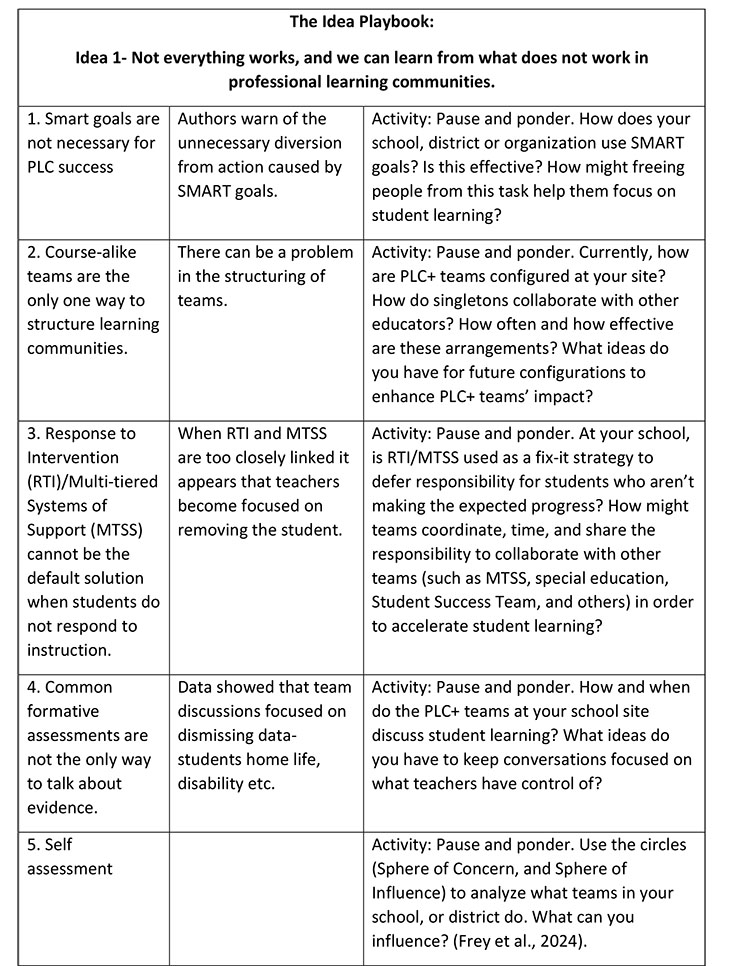
Another playbook example that invests time into articulating what the various actions look like, is that of Jim Knight and his co-writers who developed The Instructional Playbook. In their instructional playbook, Knight et al. (2020, p. 6) shared both “one-pagers” and checklists. The one-pager describes the purpose of the strategy, the research background, and teacher and student actions, which includes more comprehensive notes for the install process aimed at teachers in specific class levels. The checklists however are more than just checklists, in that they encourage the reader to consider the how of application and articulate what the various actions might look like if they were to be observed. It is this aspect that we believe is a crucial aspect of any school’s playbook. It is in this space that schools are able to begin to move from creating a simple policy document to identifying a series of processes that will support staff to adopt and embed the instructional framework that is outlined within the playbook.
It was with this in mind, that we (authors Boyd and Lehr) developed the idea of the Instructional Playbook+ at Dayton, where consideration was not just given to outlining to staff the school’s instructional framework, but also identifying structures and processes that would be utilised to support the school’s staff to embed these.
Instructional Playbook+: Dayton Primary School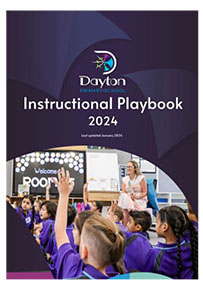 At Dayton Primary School, we have implemented an Instructional Playbook+ in our school that opened at the beginning of 2023. Our leadership philosophy is underpinned by the belief that transparency can limit uncertainty, even out differences, and improve consistency and predictability in delivering educational services, thus ensuring we can successfully attain our vision. Our Instructional Playbook+ was developed ahead of the school opening and, for transparency and consistency, was shared with prospective staff and our foundation staff to ensure the expectations for teaching and learning in every classroom in the school were clearly articulated, meaning everyone knew “what they were getting into”.
At Dayton Primary School, we have implemented an Instructional Playbook+ in our school that opened at the beginning of 2023. Our leadership philosophy is underpinned by the belief that transparency can limit uncertainty, even out differences, and improve consistency and predictability in delivering educational services, thus ensuring we can successfully attain our vision. Our Instructional Playbook+ was developed ahead of the school opening and, for transparency and consistency, was shared with prospective staff and our foundation staff to ensure the expectations for teaching and learning in every classroom in the school were clearly articulated, meaning everyone knew “what they were getting into”.
Our Instructional Playbook+ outlines pedagogic expectations for instruction, providing context and the evidence that shapes the ‘why’ behind the expectations, and also proposes further professional reading for staff. Our goal in creating a playbook was to outline an instructional delivery framework that would ensure the highest levels of consistency, both within year levels and across year levels, to enable seamless transitions from year to year and year-on-year progress. We espoused to our school community that we are committed to equipping our teachers with core knowledge, understanding and skills as the foundation for high quality teaching which meets the needs of every one of our students and ensures they reach their full potential. To realise this, we understood that, as leaders, we must know and understand what high-quality teaching is, what it looks like, and what it feels like - something that we continue to deepen our learning in.
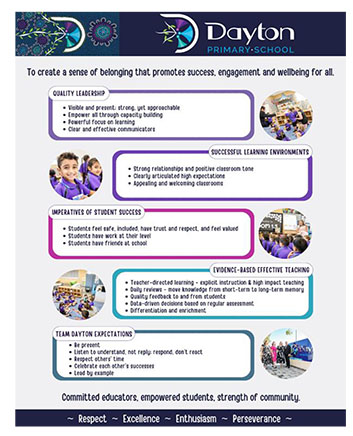 It is to be noted that simply sharing our plan for effective instruction and student success by way of a playbook isn’t the key to making a difference in relation to instruction. We could talk about what is outlined in our Instructional Playbook+ until we are “blue in the face”, and even have teachers read it, over and over, yet that is going to have very little impact on altering the instruction that occurs in each classroom. As is well known from experience and research, we learn best by doing and by implementing what we have learned, by trying out the practices, reflecting on how they are going, learning from our mistakes, and revising our practices in the pursuit of continual growth. As mentioned previously, the success of any playbook does not come from the creation of such a booklet, or even the sharing of this with the team, but hinges on the install processes that accompany this. At Dayton Primary School, some of the bespoke install processes that turned our Instructional Playbook into an Instructional Playbook+ are:
It is to be noted that simply sharing our plan for effective instruction and student success by way of a playbook isn’t the key to making a difference in relation to instruction. We could talk about what is outlined in our Instructional Playbook+ until we are “blue in the face”, and even have teachers read it, over and over, yet that is going to have very little impact on altering the instruction that occurs in each classroom. As is well known from experience and research, we learn best by doing and by implementing what we have learned, by trying out the practices, reflecting on how they are going, learning from our mistakes, and revising our practices in the pursuit of continual growth. As mentioned previously, the success of any playbook does not come from the creation of such a booklet, or even the sharing of this with the team, but hinges on the install processes that accompany this. At Dayton Primary School, some of the bespoke install processes that turned our Instructional Playbook into an Instructional Playbook+ are:
● Constantly reflecting on and refining the content of the Instructional Playbook + to ensure it is relevant to our context and by seeking for knowledge about 'best practice' to guarantee our playbook content is evidence-based and aligned with the data on what works best in teaching and learning.
● Providing clear induction processes for all staff that outline what is in the playbook, why these aspects are there, and how this looks in practice for teachers (as well as how it connects to our vision and our why).
● Offering ongoing targeted professional learning for teachers that connects back to our school vision and the expectations for teaching and learning (the framework/processes articulated in the playbook). Our professional learning is shared in staff meetings (which are not management meetings but always learning focused), the school’s staff newsletter and via articles in Teams. We ensure that all professional development is closely aligned with effective curriculum delivery and we lead these sessions ourselves (where possible).
● Having regular discussions (both formal and informal) about teaching and learning with our team, and taking on feedback about what is working well and what may need to be adapted.
● School leaders regularly being in classrooms observing teachers implementing the teaching practices outlined in the playbook and providing feedback (both formal and informal) that supports teachers to teach effectively and to continue to refine and improve.
● Building on Jim Knight’s (2020) model by strongly addressing and placing additional emphasis for the leadership team on the embedding of the instructional practices in the classrooms and into teachers’ pedagogic repertoires. Ensuring all teachers participate in instructional coaching that focuses on the practices outlined in the playbook and providing teachers the opportunity to set goals for their own personal growth focus within the mandated instructional framework. Through this instructional coaching process, and being in the classes regularly, we have ensured that when it comes to instruction we are proactive in enacting David Morrison’s (2013) mantra of “the standard you walk past is the standard you accept” - even if this has meant having difficult conversations with individuals, to ensure our students are receiving the best possible education that they can.
● Video recording lessons for the teachers to watch themselves teach, and then participating in reflective coaching conversations that include a focus on both strengths and areas for growth, with further goal setting to ensure teachers continue to improve.
● Providing additional documents that outline whole-school teaching and learning processes and expectations, our instructional coaching model, behaviour and engagement handbooks etc.
● Meeting regularly with staff to provide the opportunity to have individualised conversations on what supports they need to implement our outlined instructional framework and our whole-school programs, and what questions, concerns and curiosities they have.
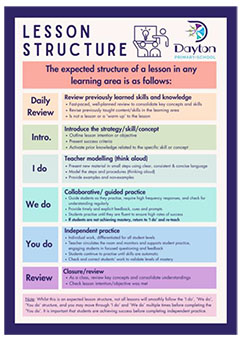 Examples from Dayton Primary School’s Instructional Playbook:
Examples from Dayton Primary School’s Instructional Playbook:
Dayton Primary School’s Instructional Playbook outlines for our staff the expected lesson structure. While it articulates, to some degree, what is involved in each stage, it does not provide examples of what this looks like, and this is where the importance of the install processes come into play. For example, whilst the “We do” section states that teachers “guide students as they practice”, it does not provide any clarity around what guided practice looks like. This is one place where you may begin to see inconsistency develop across the school if the instructional playbook was the only “point of truth”. It is the coaching, the professional learning, the in-class support and modelling from the leadership team that actually provide the necessary impetus for the structures to be understood and embedded.
Figure 2
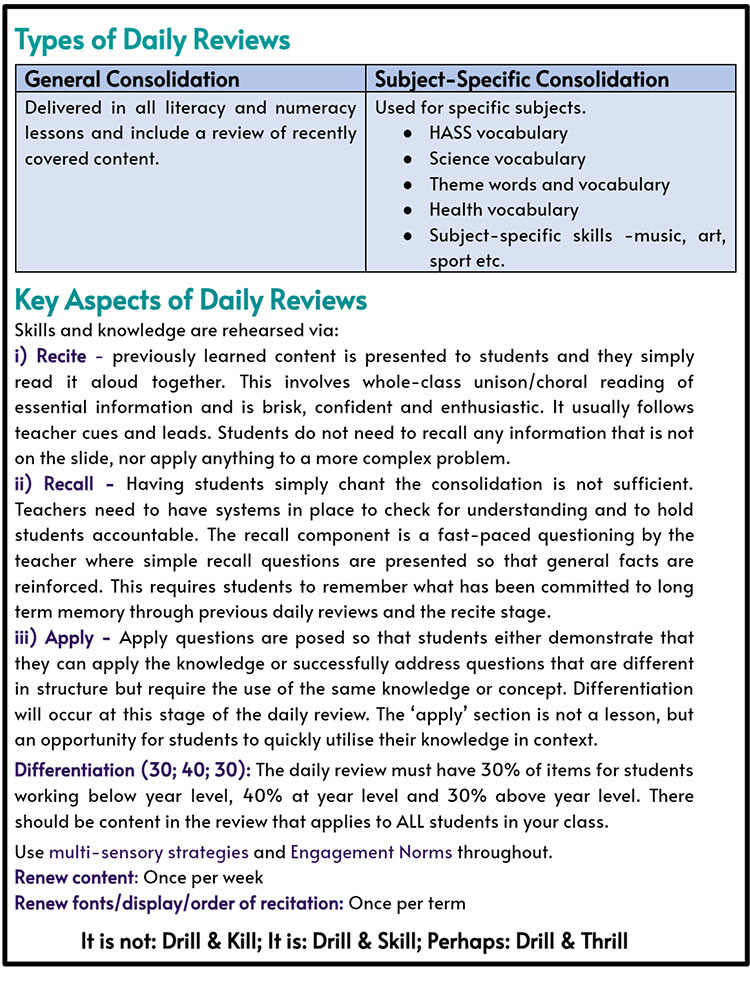
The authors of this document acknowledge the work of Fleming & Kleinhenz, Rosenshine, and Archer & Hughes, Ybarra & Hollingsworth in creating the school-based mandated lesson structure.
To add further to this, our Instructional Playbook provides descriptions, as seen in Figure 2, for teachers regarding the various elements of the daily review, as well as the why for utilising these. However, again, this only provides a general structure for teachers and is something that is common in most playbooks. It does not provide the support that enables teachers to actually enact it, as this is something that the install processes of professional learning, coaching, peer observation and collegial discussion facilitate - all elements that are often overlooked by many as they seek for pedagogic improvement in their schools through the implementation of playbooks.
We don’t propose that Dayton Primary School’s outlined bespoke model of ensuring pedagogic improvement is perfect, and we acknowledge that it is also not finished; however, it provides an example for others to consider as they develop their own instructional playbook, and offers some ‘food for thought' in relation to what additional install structures need to complement the writing of such a book.
Summary
The point that we make strongly in this paper is that the Instructional Playbook+ is not just another document that is produced for accountability purposes - it is a working, living document that guides, not just the teaching in the school, but also the leadership actions to support that teaching. We propose that to implement an instructional playbook well, the playbook needs to be the lighthouse to share a school’s vision and instructional imperatives, yet it must be matched with targeted professional learning that spotlights exactly what you are looking for, and should be rounded out with instructional coaching to support teachers in effectively applying the expected instructional framework.
Importantly, the use of an Instructional Playbook+ needs to be a process, one that grows and is refined over time, and should be shared with all teachers so it represents the school’s pedagogic ecology. Simply adopting another school’s playbook, and mandating its use is a pointless exercise, as it does not acknowledge the starting point for the genesis of the document, nor encapsulate the context and the install processes required to turn such a booklet into a living document that shapes teaching and learning in a school. That said, perusing examples of playbooks and “pulling them apart” is a useful exercise with staff in establishing commitment and in creating a personalised instructional playbook that is the best fit for your school’s instructional intent and provides an anchor for the install processes that will assist your school on its journey of pedagogic improvement.
References
Archer, A. L., & Hughes, C. A. (2010). Explicit instruction: Effective and efficient teaching. Guilford Publications.
Boyd, R., & Lehr, R. (2024). Instructional Playbook 2024. Dayton Primary School, Western Australia.
https://drive.google.com/file/d/17v06mqcCh-WsJs1wl67uK5U5NEaUu68/view?usp=sharing
Fleming, J., & Kleinhenz, E. (2007). Towards a moving school: Developing a professional learning and performance culture (No. 1). Aust Council for Ed Research.
Fisher, D., Frey, N., Almarode, J., Flories, K., & Nagel, D. (2019). PLC+: Better decisions and greater impact by design. Corwin.
Frey, N., Nagel, D., Fisher, D., Faddis, T., & Allen-Rotell, A. (2024). PLC+: A playbook for instructional leaders. Corwin.
Global Security Organization (n.d.). Appendix J. Movement techniques and battle drills. https://www.globalsecurity.org/military/library/policy/army/fm/7-93/Appj.htm
Hollingsworth, J. R., & Ybarra, S. E. (2009). Explicit direct instruction (EDI): The power of the well-crafted, well-taught lesson. Corwin Press.
Knight, J., Hoffman, A., Harris, M., & Thomas, S. (2020). The instructional playbook: The missing link for translating research into practice. ASCD.
Lang, T., & Whittington, R. (2022, May 23). The best strategies don’t just take a long view. They take a broad view. Harvard Business Review. https://hbr.org/2022/05/the-best-strategies-dont-just-take-a-long-view-they-take-a-broad-view
Layden, T. (2010). Blood, sweat and chalk: The ultimate football playbook- How the great coaches built today’s game. Sports Illustrated books.
Osborne, S. (2015). The standard you walk past is the standard you accept. ACORN, 28(2), 26-27.
Rosenshine, B. (2012). Principles of instruction: Research-based strategies that all teachers should know. American educator, 36(1), 12.
US Army Maneuver Centre of Excellence (n.d.). Appendix J-2: Essential battle drills. US Army Maneuver Centre of Excellence. https://www.moore.army.mil/Infantry/DoctrineSupplement/ATP3-21.8/appendix_j/Introduction/Introduction/index.html